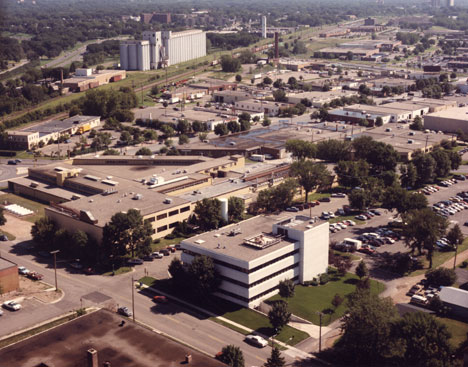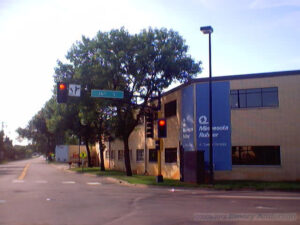Minnesota Rubber began as the (Jim) Wilson Packing and Rubber Company in 1941. Originally located in the Fawkes Building on Hennepin Ave., its 12 employees made rubber parts for military equipment. [Its first location was a garage.] The company moved to the Walker Building (6516 Walker Street) in 1942, and then across the street to the Hamilton Building (6509 Walker Street) in 1943, where it manufactured rubber gaskets for the war effort. Wilson was known as “Grandpa” Wilson to the kids.
On February 23, 1946 the company was purchased by George E. Carlson and Paul Dennison and renamed the Minnesota Rubber and Gasket Company. Dennison was elected president and Carlson was Chairman of the Board. At the time it had nine employees. The firm expanded to produce parts for private manufacturers.
A new 10,000 square foot plant was built in 1947-49 at 3601 Wooddale; other buildings were added in 1953 (3630 Wooddale), 1959 (5810 W. 37th), and 1980 (3701 Alabama – the site of the old Lincoln School). The company has been very innovative in making changes to rubber products and to the way they were manufactured, leading to the establishment of their own Machine Design Center.
Dennison passed away on September 9, 1955, and George Carlson served as President until 1957, when he was named Chairman of the Board and his son, Robert W. Carlson, Sr., became president. In June 1955, St. Louis Park resident Loren J. Sewall was promoted from Chief Estimator to Factory Superintendent. Sewall had been with the company since 1941.
On December 1, 1957, the name of the company was changed to Minnesota Rubber Company, reflecting the phasing out of gasket production. That August there had been a three-week strike of the International Association of Machinists #1037, which affected 330 employees. The Union won a 12 cent per hour raise.
In March 1958 the company came to the City Council with an urgent need to buy property at the NE corner of 37th and Wooddale (Collins 2nd addition, block 1). This had been the site of the annual Fireman’s Carnival, and 1962 was the last year for that event because of the purchase. They also needed the land rezoned from commercial to light industrial, and they needed to vacate Yosemite adjacent to that tract. They erected a new building at a cost of $15,000.
The company prospered through the 1960s; in 1963 it branched out to manufacture plastic parts, and in 1966 that operation was moved to a new plant in Watertown, South Dakota. Back in St. Louis Park, the plant suffered through a strike of 300 workers that started on July 39, 1965. A Molotov cocktail thrown through the window of Betty’s Cafeteria was said to be attributed to the acrimonious strike.
In 1966 the company purchased the old Lincoln School for $130,000, and the building was demolished shortly afterward.
In 1970 there were 500 employees.
On July 2, 1971, President Robert W. Carlson, Sr. was killed in a plane crash, which also injured his father and his son, Robert W. Carlson, Jr. Long-time employee Luke Sewall took over as President until he retired in 1977. Chairman George Carlson died in 1972. John Rentschler was named President in 1977, as Robert W. Carlson, Jr. came up the ranks and served as CEO. The company continued to expand and to buy other companies around the world.
In 1980 the office building at 3701 Alabama was built on the site of the old Lincoln School. That building stands today.
In 1986 John Rentschler retired and was replaced by Jim Lande. Lande became CEO in 1989.
TOOL PRODUCTS
Tool Products began in 1945 in the home of Al Zeiss. It moved to Franklin and Cedar in South Minneapolis in the early 1950s. After several expansions it moved to New Hope in 1973. The company was purchased by Robert W. Carlson, Jr. in 1975 and became a wholly-owned subsidiary of Minnesota Rubber, with Carlson as President.
QUADION
In the summer of 1985, Minnesota Rubber and Tool Products were reorganized under one corporate identity: Quadion Corporation. Each company retained its name but was identified as “A Quadion Company.” The term “Quadion” is derived from the four-lobed Quad-Ring seal. It also represents four important attributes of the company: “quality products, on-time delivery, superior customer service, and cost-effective pricing.” The Tool Products Division was sold in 1998.
A Quadion pamphlet described Minnesota Rubber as “dedicated to the engineering, design, compounding and manufacture of custom molded rubber components. With expertise in horizontal and vertical injection molding, the company has domestic manufacturing facilities in Minnesota, Iowa, South Dakota [and] Reynosa, Mexico.”
In 2004, with facilities in France and Singapore, the company moved its headquarters to Plymouth and sold the old plant to a developer. The Minnesota Rubber campus has been redeveloped into a residential development called Village in the Park.
Also see Something in the Water.


This perspective is looking south on Wooddale. The pictured buildings have been replaced by Village in the Park. Photo by Emory Anderson
